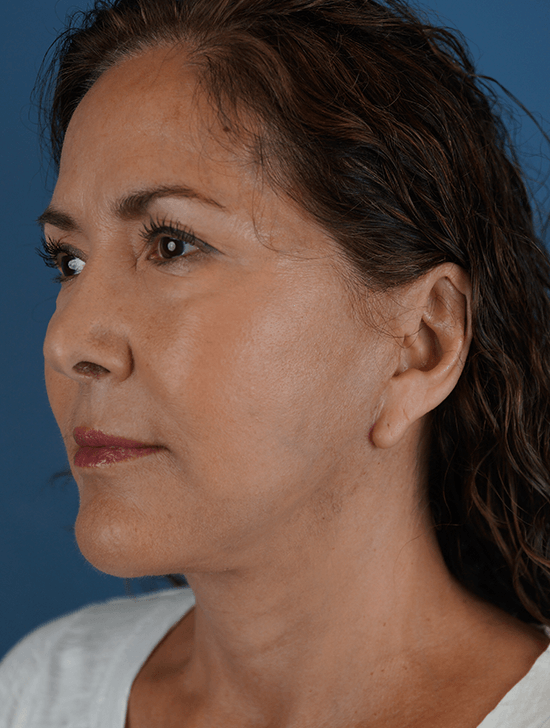

Facelift Surgery
April Special: Save 20% on facelift surgery with Dr. Atencio, Dr. Bekanich, or Dr. Erickson. Contact us today for more details.
As you age, your facial muscles slacken and your skin becomes less elastic, creating sagging in the cheeks along the jaw bone, increased appearance of the nasolabial folds, fleshy jowls, and often a double chin. A facelift is a surgical procedure that makes the face tighter and smoother by lifting up the facial skin and tissues and/or the underlying muscle. A facelift can give you a more alert and youthful appearance by reducing saggy skin and wrinkles.
Before and After Facelift Surgery
View Facelift Photo Gallery
HOW IS A FACELIFT PERFORMED?
Many of the facelifts we offer can be performed under twilight anesthesia. Your surgeon will make a surgical cut right around your hairline, past the front of your ears. Cuts may also be made under your chin if you want to lift a sagging jawline. Incisions are placed in such a way to keep them well camouflaged along the contours of the ear, and hidden at the hairlines. Your skin is carefully separated from the underlying facial muscles. Excess fat is removed and the muscles are tightened. The skin is then pulled and stitched back to the line where the cut was initially made.
Dr. Constantinides Discusses Facelift Procedures On KXAN News
WHAT TYPE OF FACELIFT IS RIGHT FOR ME?
In general, the more significant your facial laxity and excess skin, the longer the incisions need to be in order to remove an appropriate amount of skin. Patients with minimal laxity and early jowling or excessive neck skin are good candidates for a mini facelift. Most patients with a greater amount of excess skin would enjoy a more dramatic result from a full lift. These procedures can also be combined with eyelid surgery, and various brow-lifting techniques to give a more harmonious result to the entire face. You will be able to meet with your surgeon to discuss which options are best for you.
We offer several facelift technique options at Westlake Dermatology & Cosmetic Surgery. The most common types we offer are the SMAS (which stands for “superficial muscular aponeurotic system”) Facelift and the Deep Plane Facelift. Your procedure will be based on your desired outcome and individual needs. To learn more about a variety of facelift options, please see this article.
WHAT IS A SMAS FACELIFT?
The SMAS Facelift (sometimes called a SMAS rhytidectomy), is a surgical procedure that targets the lower two-thirds of the face by tightening the muscle and trimming excess skin. It addresses loose and sagging skin, excess fat, jowls, and loss of volume in the cheeks and lower face. It is less invasive than a traditional facelift, thus allowing for fewer risks and a quicker recovery.
In this procedure, an incision is made at the temple above the hairline between the tissue and the muscle (without dissecting into the muscle). The incision extends downward along the natural creases of the skin and curves behind the ears. Facial and neck tissue and muscle beneath the skin are lifted and rearranged into a higher position and excess skin is removed. The skin is then redraped over the face and the incisions are closed with sutures. Most of the scars will be hidden within the hair and the normal creases of the skin.
Oftentimes if a patient also wants to address the upper portion of their face, a Brow Lift surgery can be performed at the same time.
WHAT IS A DEEP PLANE FACELIFT?
A Deep Plane Facelift is an advanced technique where the SMAS (the muscular layer of the face) along with fat and skin are lifted as a single unit. A deeper pull underneath the muscle allows deep plane lifts to address most areas of the face simultaneously – including the midface, marionette lines, and neck. Since the pull occurs deep under surface, the overlying skin never looks pulled. Deep plane lifts performed at Westlake Dermatology use short scars that minimize incisions in the hair.
WHAT IS A MINI FACELIFT?
A mini lift may be an option for younger patients with early sagging and relatively less laxity who are looking for a natural-looking lift in the lower face or neck areas. Compared to other lift options, it is a quicker surgery with fewer complications and a quicker recovery. However, a mini facelift does not address laxity of skin on the neck, and typically if there is any sagging of the lower face the neck should also be addressed.
WHAT SHOULD I EXPECT AFTER MY PROCEDURE?
After your surgery, your face is tightly wrapped in bandages. Depending on the exact procedure carried out, these may run under your chin, around your ears and/or over your head. They are usually taken off after a day or two. Dissolvable stitches will disappear on their own in seven to ten days. Non-dissolvable stitches are removed a week after surgery.
Most people can return to work after about two weeks. To help promote your recovery, it’s important that you minimize your exposure to the sun and refrain from any vigorous activity for four to five weeks following your surgery.
The effects of a facelift last for about seven to ten years. The best results are achieved if you maintain a stable body weight, have skin with good levels of elasticity, and have a strong bone structure.
Meet Our Facelift Surgeons
- Daniela Atencio, MD (Downtown Austin)
- Amy Bekanich, MD (Domain Northside)
- Minas Constantinides, MD, FACS (Lamar Central)
- Cameron Craven, MD, FACS (Westlake)
- Cameron Erickson, MD (West University, Houston)
- Timothy McGee, MD (Round Rock)
How Much Does Facelift Surgery Cost?
Depending on the type of facelift performed and the overall complexity of the procedure, the total cost of a facelift procedure can vary greatly from individual to individual. Learn more about facelift prices
Are There Risks?
There are risks associated with any surgical procedure. However, facelift surgery is considered relatively safe with most patients experiencing minimal post-procedure side effects. Common side effects include pain, swelling, bruising, and nausea (due to anesthesia use), all of which typically resolve without intervention. Pain and discomfort during recovery can be effectively managed through pain medication. While scarring is also possible, experienced surgeons will strategically place their incisions to minimize their visibility. Uncommon side effects can include hematoma, bleeding, infection, skin discoloration, or a temporary tingling or numbness feeling.
Additional Facelift Resources
- Awake Facelifts: What You Need to Know
- Exercising After Facelift Surgery: What to Expect
- Facelift Incision Placement & Scars
- Full Facelift vs. Mini Face Lift: What’s the Difference?
- 10 Questions To Ask Before A Facelift (And Why To Ask Them)
- Male vs. Female Facelift: What’s The Difference?
- How Long Does A Facelift Last?
- The Pros and Cons of a Mini Facelift
- Facelift Recovery: Tips + What To Expect
- 5 Common Facelift Myths Debunked
- Do I Need Dermal Fillers Or A Facelift?
- All About Mid-Facelift Surgery
- Facelift vs. Neck Lift: What’s the difference?
- Type of Facelifts: Which Technique Is Right For You?
- ASPS Overview of Facelift Surgery
- Facelift: How Much Younger Can You Look?
- Understanding Facelift Surgery – AAFPRS
- MedlinePlus Research on Facelift
 Before
Before  After
After  Before
Before  After
After 